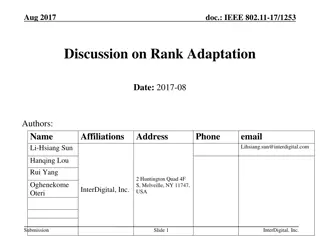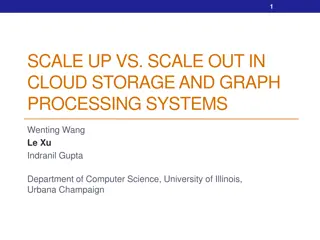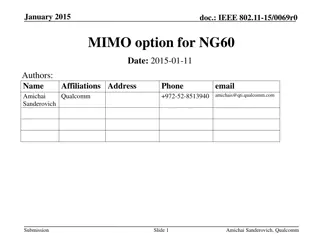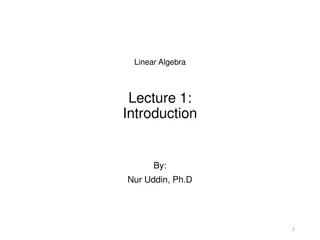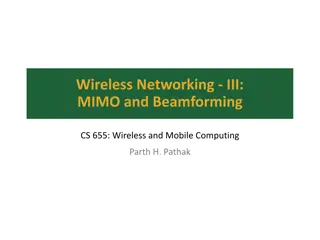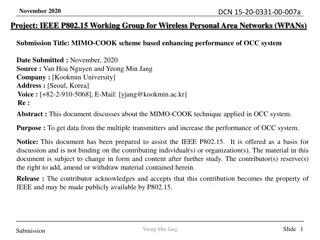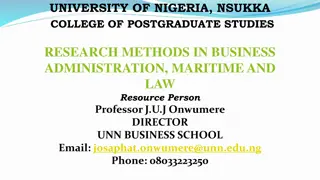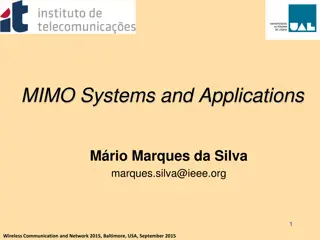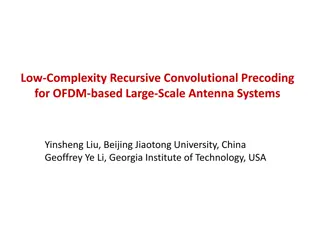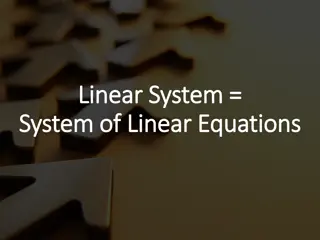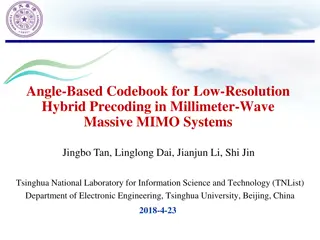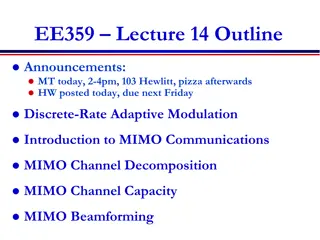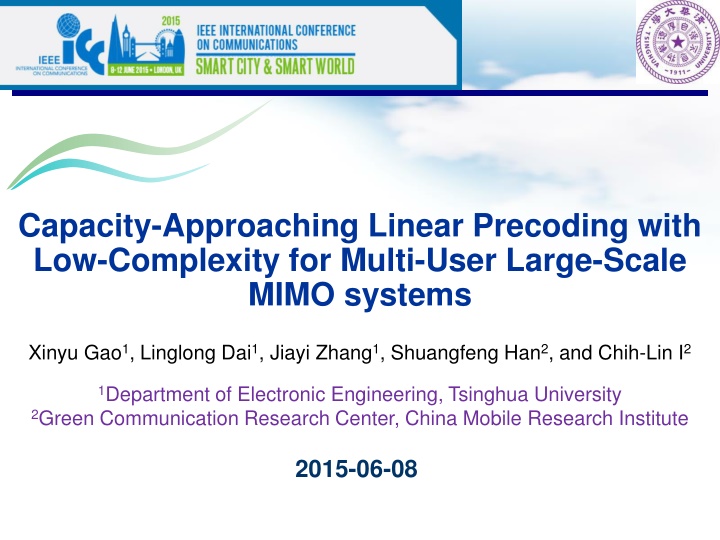
Capacity-Approaching Linear Precoding for Large-Scale MIMO Systems
Capacity-approaching linear precoding methods with low complexity are crucial for enhancing the performance of multi-user large-scale MIMO systems. This study explores the advantages, challenges, and various precoding schemes in the context of large-scale MIMO technology, emphasizing the need for efficient pilot pattern design, reliable channel estimation, and low-complexity precoding techniques.
Download Presentation

Please find below an Image/Link to download the presentation.
The content on the website is provided AS IS for your information and personal use only. It may not be sold, licensed, or shared on other websites without obtaining consent from the author. If you encounter any issues during the download, it is possible that the publisher has removed the file from their server.
You are allowed to download the files provided on this website for personal or commercial use, subject to the condition that they are used lawfully. All files are the property of their respective owners.
The content on the website is provided AS IS for your information and personal use only. It may not be sold, licensed, or shared on other websites without obtaining consent from the author.
E N D
Presentation Transcript
Capacity-Approaching Linear Precoding with Low-Complexity for Multi-User Large-Scale MIMO systems Xinyu Gao1, Linglong Dai1, Jiayi Zhang1, Shuangfeng Han2, and Chih-Lin I2 1Department of Electronic Engineering, Tsinghua University 2Green Communication Research Center, China Mobile Research Institute 2015-06-08
Contents 1 Technical Background 2 Proposed Solution 3 Complexity Analysis 4 Simulation Results 5 Conclusions 2/20 Capacity-Approaching Linear Precoding with Low-Complexity for Multi-User Large-Scale MIMO systems
Advantages and challenges of large-scale MIMO What is large-scale MIMO? Large antenna array at BS Advantages Improve the spectrum and energy efficiency by orders of magnitude key technology for 5G Challenges[Rusek 13] Efficient pilot pattern design under pilot contamination Reliable channel estimation and channel feedback Low-complexity capacity-approaching precoding [1] F. Rusek, etc, Scaling up MIMO: Opportunities and Challenges with Very Large Arrays ,IEEE Signal Processing Magazine, vol. 30, no. 1, pp. 40-60, Feb. 2013. 3/20 Capacity-Approaching Linear Precoding with Low-Complexity for Multi-User Large-Scale MIMO systems
Precoding schemes: linear vs. nonlinear Nonlinear precoding (DPC) Eliminate interferences by successive encoding and decoding Optimal but prohibitively high complexity for large-scale MIMO Linear precoding Eliminate interferences by linear precoding matrix Low complexity compared to nonlinear schemes Near optimal when (4 times or more) N K Linear precoding is more attractive for large-scale MIMO! 4/20 Capacity-Approaching Linear Precoding with Low-Complexity for Multi-User Large-Scale MIMO systems
Classical linear ZF precoding ZF precoding Precoding matrix ZF = P K W = = H = = W HH 1 1 H H H where , 1. , H H H HH H W ( ) , ( ) tr Transmitted signal vector after precoding = = 1 H H . t H W s H s Problem when dimension is large Complicated matrix inversion with a large number of divisions W 1 Existing method: Neumann-based precoding [Prabhu 13] Convert matrix inversion into matrix-matrix/vector multiplications Complexity reduction is not obvious if high accuracy is required [1] H. Prabhu, etc, Approximative matrix inverse computations for large-scale MIMO and applications to linear pre-coding systems, in Proc. IEEE Wireless Communications and Networking Conference (WCNC 13), Apr. 2013, pp. 2710 2715. 5/20 Capacity-Approaching Linear Precoding with Low-Complexity for Multi-User Large-Scale MIMO systems
Contents 1 Technical Background 2 Proposed Solution 3 Complexity Analysis 4 Simulation Results 5 Conclusions 6/20 Capacity-Approaching Linear Precoding with Low-Complexity for Multi-User Large-Scale MIMO systems
Gauss-Seidel (GS) based precoding Target Compute with low complexity, where = s W s 1 = H W HH W Decomposition of Decompose W into a diagonal, a strictly lower triangular, and a strictly upper triangular component W = + + H D L L Utilize the GS method Approximation of = ( 1 s = W s D+L + = ( 1) 1 ( ) i i H s s L s ) ( ), 0,1,2, i Precode the transmitted signal vector + = ( 1) H i t H s Notation W is an Hermitian positive define matrix GS-based precoding is convergent for any initial solution! 7/20 Capacity-Approaching Linear Precoding with Low-Complexity for Multi-User Large-Scale MIMO systems
Power constraint of GS-based precoding Power constraint The precoding matrix should satisfy For ZF precoding, we have Precoding matrix of GS-based precoding Define iteration matrix as Precoding matrix GS = P = + ( ) H P P K tr ) . K ( H P P tr = ZF ZF ( ) 1 = I + ( GS H B H D L B L GS H ( ) + 1) 1 i 17 W GS K H H P P P P 1 N 16 tr GS GS tr ZF ZF 2 GS 2 ZF 15 ) ) ( ( ( ) ( ) ( 1) i + ( 1) i + + ( 1) GS H i H B B B B Total transmit power tr tr . GS GS GS 14 Observation or we have N H = 13 i HPGS), i=2 HPGS), i=3 HPGS), i=4 HPZF) tr(PGS tr(PGS tr(PGS tr(PZF 12 ) H P P P P = tr GS GS tr ( ZF ZF 2 GS 2 ZF 11 ( ) H H P P P P tr =tr = K If , GS ZF GS GS ZF ZF 10 2 10 15 20 25 30 30 32 = N/K 8/20 Capacity-Approaching Linear Precoding with Low-Complexity for Multi-User Large-Scale MIMO systems
Convergence rate: GS vs. Neumann Convergence rate Definition: ( ) )( ) ( + 1 i + = = = ( 1) ( ) i (0) i s s s s s B s B ( ) + ( 1) i + 1 i + ( 1) (0) (0) i s s s s s s B B F 2 2 2 F The smaller is, the faster convergence rate will be GS F B GS-based precoding vs. Neumann-based precoding Iteration matrix ( ) GS = + B D L GS: ( ) = + 1 H B D L L 1 Neumann: H L N With some standard mathematical operations, we have B B / 2 GS N F F Faster convergence rate can be achieved by GS-based precoding Capacity-Approaching Linear Precoding with Low-Complexity for Multi-User Large-Scale MIMO systems 9/20
Quantified convergence rate B Quantified By utilizing Matrix W is diagonally dominant Theory of random matrix Law of large number (convergence rate) can be well approximated by GS F B GS F 1 2 K K B Theoretical value Practical value 0.9 GS 2 F N 0.8 Conclusion The larger N is, the faster convergence rate will be GS-based precoding is appropriate for large-scale MIMO 0.7 0.6 0.5 0.4 0.3 0.2 0.1 0 8 20 30 40 50 = N/K 60 70 80 90 100 10/20 Capacity-Approaching Linear Precoding with Low-Complexity for Multi-User Large-Scale MIMO systems
Contents 1 Technical Background 2 Proposed Solution 3 Complexity Analysis 4 Simulation Results 5 Conclusions 11/20 Capacity-Approaching Linear Precoding with Low-Complexity for Multi-User Large-Scale MIMO systems
Complexity analysis How to measure the complexity? Since both ZF precoding and GSP need to compute matrix W, we consider the complexity after we have obtained W. We evaluate the complexity in terms of required number of multiplications and divisions Where does the complexity comes from? Solve the linear equation Compute Calculate the factor + = ( 1) 1 ( ) i i H s D+L s L s ( ) ( ). i+ ( 1) H H s ( ) = = 1 W / tr K GS ZF 12/20 Capacity-Approaching Linear Precoding with Low-Complexity for Multi-User Large-Scale MIMO systems
Quantified complexity (1) Solve the linear equation The solution of can be presented as 1 ( m m m k k m m m w + = ( 1) 1 ( ) i i H s D+L s L s ( ) ( ) + + = = ( 1) ( k 1) ( ) i k i i s s ), , 1,2, , s s w w m k K , , m k k m , 2 K Total required number of multiplications is according to theory of random matrix, no division is required , m m w N i+ Compute The multiplication of a matrix and a vector Require times of multiplications No division is required ( 1) H H s H H M M K i+ s 1 ( 1) MK 13/20 Capacity-Approaching Linear Precoding with Low-Complexity for Multi-User Large-Scale MIMO systems
Quantified complexity (2) A property K W = = = ( 1) K , , / M K M K ( ) GS ZF 1 tr 15 Theoretical Practical Calculate the factor When the configuration of MIMO is fixed is known and constant requires N multiplications No division is required GS 10 GS + ( 1) H i H s 5 0 2 4 6 8 =M/K 10 12 14 16 14/20 Capacity-Approaching Linear Precoding with Low-Complexity for Multi-User Large-Scale MIMO systems
Comparison of complexity: Table Computational Complexity The overall complexity is without any divisions Complexity comparison + + 2 N NK iK Iteration number i = i = i = i = i = i = Neumann-based precoding[Prabhu 14] N NK + + N NK + + N NK + N K N + + N NK + + N NK + + GS-based precoding NK + NK + NK + NK + NK + NK + + + + + + + 2 2 3 4 5 6 7 2 N N N N N N K K K K K K 3 K + 3 4 5 K K K 3 2 3 4 5 6 7 + K 3 2 3 2 2 2 2 2 K K K K 2 3 3 2 2 K K 3 2 2 3 2 The complexity can be reduced from to ! ( ) ( ) O K O K [1] H. Prabhu, J. Rodrigues, O. Edfors, and F. Rusek, Approximated matrix inverse computations for large-scale MIMO and applications to linear pre-coding systems, in Proc. IEEE Wireless Communications and Networking Conference (WCNC 13), Apr. 2013, pp. 40-60. 15/20 Capacity-Approaching Linear Precoding with Low-Complexity for Multi-User Large-Scale MIMO systems
Contents 1 Technical Background 2 Proposed Solution 3 Complexity Analysis 4 Simulation Results 5 Conclusions 16/20 Capacity-Approaching Linear Precoding with Low-Complexity for Multi-User Large-Scale MIMO systems
Simulation results Simulation setup Parameters: (1) M=256, K=16 (2) M=256, K=32 Modulation schemes: 64 QAM Channel: Rayleigh fading channel Initial solution: zero-vector 240 Neumann-based precoding, i=2 Neumann-based precoding, i=3 Neumann-based precoding, i=4 Neumann-based precoding, i=5 GS-based precoding, i=2 GS-based precoding, i=3 GS-based precoding, i=4 GS-based precoding, i=5 ZF precoding DPC precoding 450 Neumann-based precoding, i=4 Neumann-based precoding, i=5 Neumann-based precoding, i=6 Neumann-based precoding, i=7 GS-based precoding, i=2 GS-based precoding, i=3 GS-based precoding, i=4 GS-based precoding, i=5 ZF precoding DPC precoding 220 400 200 350 180 Capacity bps/Hz 300 Capacity bps/Hz 160 250 140 200 120 150 100 100 80 The GS-based precoding scheme is capacity-approaching! 50 60 0 5 10 15 20 25 30 0 5 10 15 20 25 30 SNR (dB) SNR (dB) 17/20 Capacity-Approaching Linear Precoding with Low-Complexity for Multi-User Large-Scale MIMO systems
Contents 1 Technical Background 2 Proposed Solution 3 Complexity Analysis 4 Simulation Results 5 Conclusions 18/20 Capacity-Approaching Linear Precoding with Low-Complexity for Multi-User Large-Scale MIMO systems
Conclusions In this report, a GS-based precoding is proposed to achieve the capacity- approaching performance in an iterative way without complicated matrix inversion of large size. Mathematical analysis shows that: = 1) GS-based precoding satisfies the power constraint if we set 2) GS-based precoding enjoys faster convergence rate than Neumann- based precoding; 3) faster convergence rate can be achieved by increasing the number of BS antennas GS ZF The complexity analysis shows that the proposed scheme can reduce the complexity from to . ( ) O K ( ) O K 3 2 The simulation results demonstrate that the proposed scheme outperforms the Neumann-based precoding and achieves the exact capacity- approaching performance of ZF precoding with a small number of iterations. 19/20 Capacity-Approaching Linear Precoding with Low-Complexity for Multi-User Large-Scale MIMO systems
Thanks for your attention ! 20/20 Capacity-Approaching Linear Precoding with Low-Complexity for Multi-User Large-Scale MIMO systems





